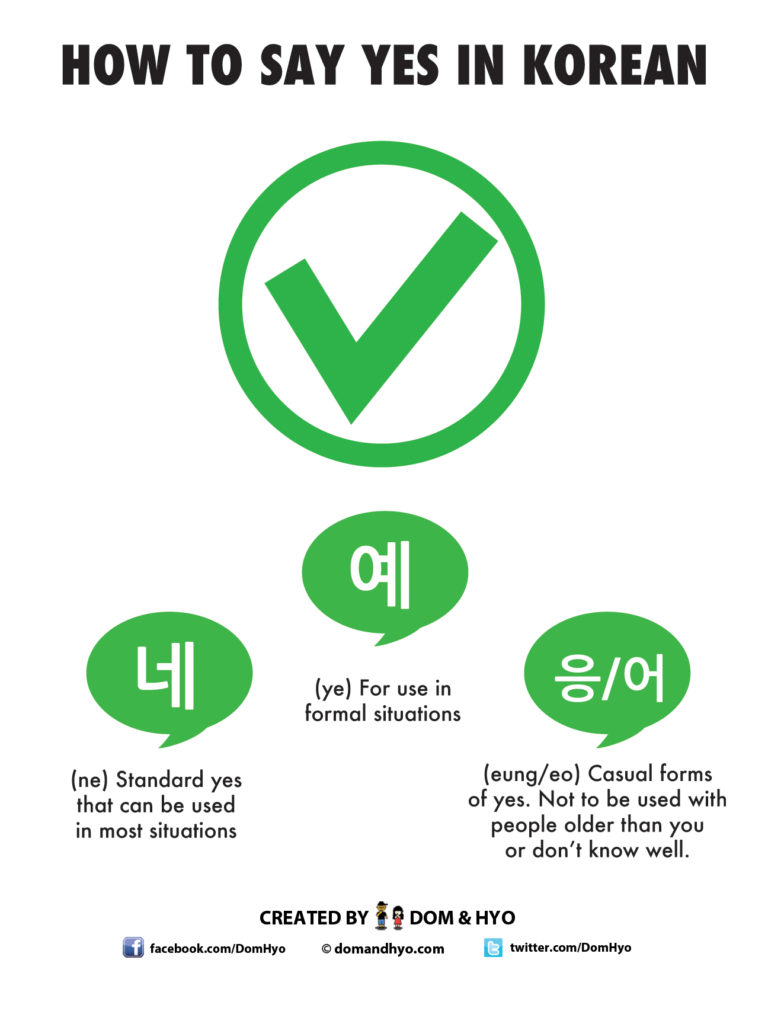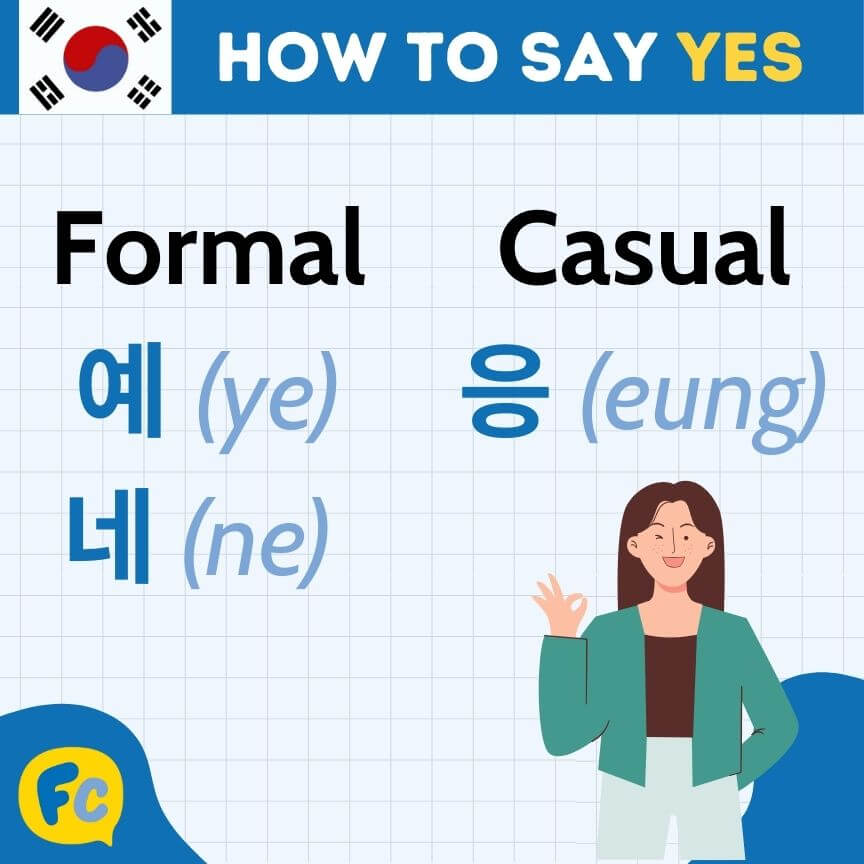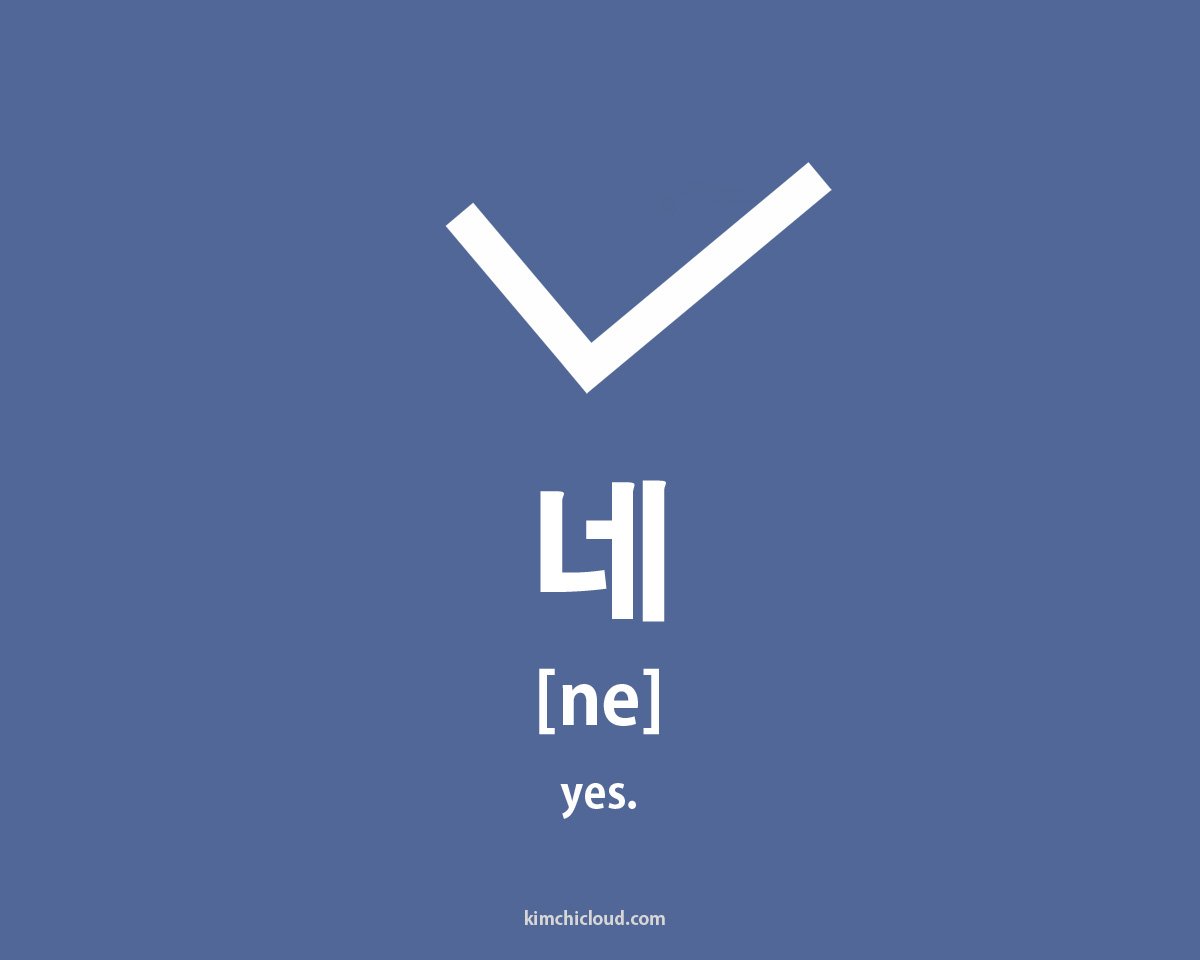Yes In Korean: A Comprehensive Guide To Mastering The Korean Word For Yes
Learning how to say "yes" in Korean is one of the most fundamental aspects of Korean language acquisition. Whether you're traveling to Korea or simply interested in learning Korean, understanding the nuances of saying "yes" will help you communicate more effectively. In this article, we'll explore various ways to say "yes" in Korean, their appropriate contexts, and cultural insights that will enhance your language skills.
Communication is the key to connecting with people from different cultures, and Korean is no exception. The Korean language offers several ways to express agreement or affirmation, and each has its unique usage depending on the situation and the relationship between speakers. By the end of this article, you'll have a solid understanding of how to use "yes" in Korean appropriately.
This guide is designed for both beginners and intermediate learners who want to enhance their Korean vocabulary. We'll cover the basics, advanced usages, and cultural tips to ensure you can confidently use "yes" in any Korean conversation. Let's dive in!
Read also:Kristen Gayle The Rising Star In The Entertainment Industry
Table of Contents
- Introduction to Yes in Korean
- Basic Forms of Saying Yes in Korean
- Polite Forms of Yes in Korean
- Informal Usage of Yes in Korean
- Contextual Usage of Yes in Korean
- Cultural Insights on Saying Yes in Korean
- Common Mistakes When Saying Yes in Korean
- Advanced Usage of Yes in Korean
- Practical Examples of Yes in Korean
- Conclusion and Next Steps
Introduction to Yes in Korean
When learning Korean, understanding how to say "yes" is essential for effective communication. The Korean language offers multiple ways to express affirmation, and each carries a specific tone or level of politeness. For instance, "네" (ne) is a common way to say "yes" in Korean, but it's just the tip of the iceberg.
Understanding the nuances of saying "yes" in Korean is crucial because Korean is a highly contextual language. The word you choose depends on the relationship between the speakers, the formality of the situation, and cultural norms. This guide will help you navigate these complexities.
Why Learn Yes in Korean?
Learning how to say "yes" in Korean is not just about expanding your vocabulary; it's about understanding the culture and customs that influence language use. Korean culture places a strong emphasis on respect and hierarchy, which directly affects how you communicate.
Basic Forms of Saying Yes in Korean
Let's start with the most fundamental forms of "yes" in Korean. These are the words you'll use in everyday conversations.
- 네 (ne) – The standard way to say "yes" in Korean.
- 예 (ye) – A more polite version of "yes," often used in formal settings.
Both "네" and "예" are widely used, but their appropriateness depends on the context. For example, "네" is suitable for casual conversations with friends, while "예" is better for speaking to elders or superiors.
Differences Between 네 and 예
The distinction between "네" and "예" lies in their levels of politeness. "네" is neutral and can be used in most situations, whereas "예" conveys respect and is often reserved for formal or respectful interactions.
Read also:Lela Sohna Nides The Rising Star In The Entertainment World
Polite Forms of Yes in Korean
In Korean culture, politeness is paramount. When speaking to someone older or in a position of authority, it's important to use polite language. Here are some polite forms of "yes" in Korean:
- 네 (ne) – Neutral and polite.
- 예 (ye) – More formal and respectful.
- 네, 알겠습니다 (ne, algesseubnida) – "Yes, I understand" – a very polite way to express agreement.
Using polite forms of "yes" shows respect and adherence to Korean cultural norms. It's especially important in professional settings or when speaking to elders.
When to Use Polite Forms
Polite forms of "yes" should be used when:
- Speaking to someone older than you.
- Communicating in a professional environment.
- Addressing someone in a position of authority.
Informal Usage of Yes in Korean
Informal settings allow for more relaxed language use. When speaking with friends or people of the same age, you can use less formal versions of "yes." Here are some examples:
- 응 (eung) – A casual, informal way to say "yes." Often used among friends.
- 그래 (geurae) – "Okay" or "got it" – commonly used in casual conversations.
While these forms are acceptable in informal contexts, they may come across as disrespectful if used inappropriately. Always consider the relationship between you and the person you're speaking to.
Context Matters in Informal Conversations
In Korean, context determines the appropriateness of informal language. Using informal forms of "yes" with strangers or elders can be seen as rude. Stick to polite forms unless you're sure the setting is informal and the other person is comfortable with casual language.
Contextual Usage of Yes in Korean
The way you say "yes" in Korean can vary depending on the context. Here are some common scenarios where different forms of "yes" are appropriate:
- At Work: Use "네" or "예" to maintain professionalism.
- With Friends: "응" or "그래" are perfectly acceptable.
- With Family: Depending on the age difference, you might use "네," "예," or "응."
Understanding the context is key to using the right form of "yes" in Korean. It's not just about the word itself but also about the tone and body language that accompany it.
How Context Affects Language Choice
Korean culture emphasizes respect and hierarchy, which heavily influences language use. Always consider the age, status, and relationship between speakers when choosing how to say "yes." This cultural sensitivity will help you communicate more effectively.
Cultural Insights on Saying Yes in Korean
Language and culture are deeply intertwined, and Korean is no exception. Here are some cultural insights that will enhance your understanding of saying "yes" in Korean:
- Respect for Elders: In Korean culture, showing respect to elders is crucial. Always use polite forms of "yes" when speaking to someone older than you.
- Hierarchical Structure: Korean society is hierarchical, and language reflects this. Using the appropriate form of "yes" demonstrates awareness of social structures.
- Non-Verbal Communication: In addition to words, body language and tone play a significant role in Korean communication. Nodding your head while saying "yes" can reinforce your agreement.
These cultural insights will help you navigate Korean conversations more confidently and respectfully.
Importance of Cultural Awareness
Cultural awareness is vital when learning Korean. By understanding the cultural context of language use, you can avoid misunderstandings and build stronger relationships with Korean speakers.
Common Mistakes When Saying Yes in Korean
Even experienced learners can make mistakes when saying "yes" in Korean. Here are some common errors to avoid:
- Using informal forms with elders or superiors.
- Forgetting to adjust your tone based on the context.
- Ignoring non-verbal cues that accompany verbal agreement.
Avoiding these mistakes will improve your communication skills and show respect for Korean cultural norms.
How to Avoid Mistakes
To avoid common mistakes, always consider the context and the relationship between speakers. Practice adjusting your language based on the situation, and pay attention to non-verbal cues like body language and tone of voice.
Advanced Usage of Yes in Korean
Once you've mastered the basics, you can explore more advanced ways to say "yes" in Korean. These forms are often used in specific situations or to convey nuanced meanings:
- 네, 알겠습니다 (ne, algesseubnida) – "Yes, I understand" – a very polite way to express agreement.
- 그렇습니다 (geureopnida) – "That's correct" – used in formal or written contexts.
These advanced forms of "yes" are ideal for formal situations or when you want to convey a deeper level of agreement.
When to Use Advanced Forms
Advanced forms of "yes" should be used in formal settings or when you want to convey a higher level of respect. They're also useful in written communication or official documents.
Practical Examples of Yes in Korean
Here are some practical examples of how to use "yes" in Korean in different contexts:
- Casual Conversation: "응, 그렇게 하자!" (eung, geureoke haja!) – "Yeah, let's do that!"
- Formal Meeting: "네, 알겠습니다." (ne, algesseubnida) – "Yes, I understand."
- With Elders: "예, 아버지." (ye, abeoji) – "Yes, Father."
These examples demonstrate the versatility of "yes" in Korean and how it can be adapted to fit various situations.
Practicing Practical Examples
Practicing these examples will help you become more comfortable using "yes" in Korean in real-life situations. Try incorporating them into your conversations to improve your fluency.
Conclusion and Next Steps
In this comprehensive guide, we've explored the various ways to say "yes" in Korean, from basic forms to advanced usages. Understanding the nuances of saying "yes" in Korean is essential for effective communication and cultural sensitivity. By mastering these forms and their appropriate contexts, you'll be able to engage in meaningful conversations with Korean speakers.
Now it's your turn to take action! Practice using "yes" in Korean in different situations, and don't hesitate to ask questions or seek feedback from native speakers. For further learning, consider exploring other aspects of Korean language and culture to deepen your understanding.
Feel free to share this article with others who might find it helpful, and leave a comment below to let us know your thoughts. Happy learning!
Article Recommendations


